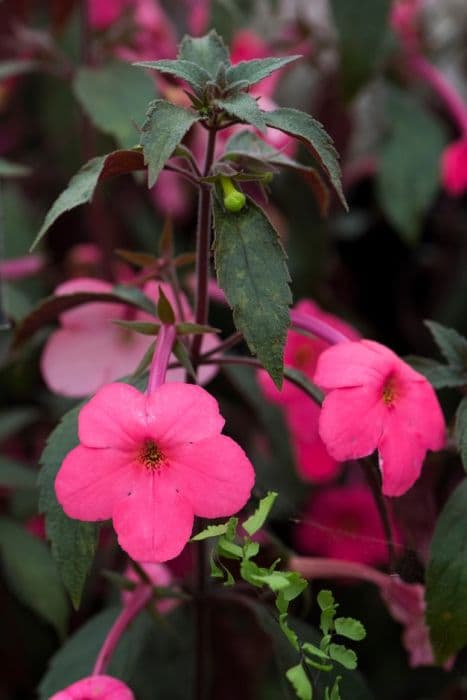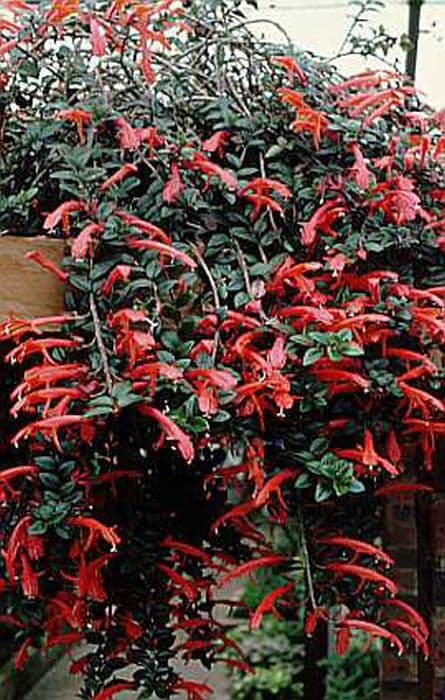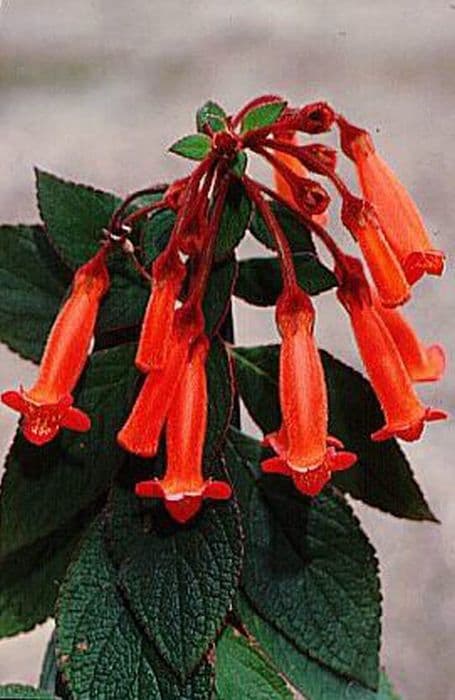Cape Primrose Streptocarpus 'Lisa'

ABOUT
Streptocarpus 'Lisa', commonly known as Cape primrose, exhibits velvety, deep green leaves which typically grow in a rosette form. The foliage often has a fine texture with a robust appearance. Flower stalks emerge from the base of the plant and gracefully arch above the foliage, showcasing the plant's stunning blossoms. The blooms are trumpet-shaped, known for their intricate and vivid color patterns, often showcasing a beautiful combination of shades, such as purples, pinks, whites, and blues, frequently accented with delicate markings or throat markings that can be of a contrasting color. The flowers of the Cape primrose are borne in clusters at the top of slender stems and can create a striking display when in bloom.
About this plant
 Names
NamesFamily
Gesneriaceae.
Synonyms
Cape Primrose, African Violet Cousin.
Common names
Streptocarpus 'Lisa'
 Toxicity
ToxicityTo humans
Cape Primrose (Streptocarpus 'Lisa') is not known to be toxic to humans. Therefore, ingestion of this plant is not commonly associated with any symptoms of poisoning and is considered generally safe in terms of human toxicity.
To pets
Cape Primrose is also not known to be toxic to pets. It should not cause any symptoms of poisoning if ingested by animals such as cats or dogs. As with many non-toxic plants, ingestion in significant quantities may potentially cause mild gastrointestinal upset due to the foreign matter in the animal's stomach, but no specific toxic effects are expected.
 Characteristics
CharacteristicsLife cycle
Perennials
Foliage type
Evergreen
Color of leaves
Green
Flower color
Varies
Height
1 foot (30 centimeters)
Spread
1 foot (30 centimeters)
Plant type
Herb
Hardiness zones
10
Native area
Africa
Benefits
 General Benefits
General Benefits- Low Maintenance: Streptocarpus 'Lisa', commonly known as Cape Primrose, typically requires minimal care, making it ideal for people with busy lifestyles or those new to gardening.
- Long Blooming Period: Cape Primrose offers a lengthy blooming season, often flowering from late spring until autumn, providing consistent beauty in an indoor or outdoor setting.
- Variety of Colors: The blossoms of Cape Primrose come in a variety of colors, which can brighten up any space and offer visual interest.
- Compact Size: With its compact growth habit, Cape Primrose is suitable for small spaces such as apartments or desks, where it can add a touch of nature without taking up too much room.
- Indoor Decor: These plants can enhance the aesthetic appeal of an indoor environment, adding a lush, vibrant element to home decor.
- Easy to Propagate: Cape Primrose can be easily propagated from leaf cuttings, allowing gardeners to multiply their plants and share with others without purchasing new ones.
- Attracts Pollinators: When grown outdoors, Cape Primrose can attract beneficial pollinators like butterflies, aiding in the pollination of garden plants.
 Medical Properties
Medical PropertiesThis plant is not used for medical purposes.
 Air-purifying Qualities
Air-purifying QualitiesThis plant is not specifically known for air purifying qualities.
 Other Uses
Other Uses- Art Projects: The vibrant colors and unique patterns on Streptocarpus 'Lisa' petals can be used by artists as inspiration for watercolor paintings or fabric designs.
- Photography Subjects: The distinct appearance of Streptocarpus 'Lisa' flowers makes them excellent subjects for macro photography workshops and botanical photo collections.
- Educational Tool: Botany teachers can use Streptocarpus 'Lisa' to demonstrate plant care, flowering cycles, and hybridization techniques to students.
- Decoration: The long-lasting blooms of Streptocarpus 'Lisa' are ideal for adding a natural aesthetic touch to table settings or as part of a centerpiece for events.
- Color Dye: Petals of Streptocarpus 'Lisa' can be boiled to produce natural dyes for small-scale fabric or craft projects.
- Gifts: Potted Streptocarpus 'Lisa' make thoughtful living gifts that can convey messages like congratulations, sympathy, or friendship.
- Study Subject: Streptocarpus 'Lisa' can serve as a specimen for scientific research on plant growth, flowering patterns, or hybrid vigor in horticultural studies.
- Relaxation Aid: The sight and subtle scent of Streptocarpus 'Lisa' may help in creating a calming atmosphere in places like spas or yoga studios.
- Hobby Cultivation: Enthusiasts may enjoy crossbreeding different varieties of Streptocarpus 'Lisa' to create new, unique hybrids as a personal hobby.
- Theme Gardens: Streptocarpus 'Lisa' can be included in a 'Victorian' themed garden due to its lush foliage and ornamental flowers, reminiscent of the plant collections of that era.
Interesting Facts
 Feng Shui
Feng ShuiThe Cape Primrose is not used in Feng Shui practice.
 Zodiac Sign Compitability
Zodiac Sign CompitabilityThe Cape Primrose is not used in astrology practice.
 Plant Symbolism
Plant Symbolism- Persistence: Streptocarpus, often known as Cape Primrose, can bloom continuously under the right conditions, symbolizing the trait of persistence and the ability to thrive despite challenges.
- Hope and Renewal: Cape Primrose has the ability to produce new flowers after periods of rest, which can symbolize hope and the idea of new beginnings or renewal.
- Adaptability: Native to South Africa, Cape Primrose can adapt to various light conditions, representing flexibility and the ability to thrive in diverse environments.
- Longevity: With proper care, Streptocarpus 'Lisa' can have a long lifespan, which makes it a symbol of enduring life and long-lasting relationships.
- Charm and Beauty: The striking appearance of the Cape Primrose, with its colorful blooms, symbolizes enchantment, charm, and natural beauty.
 Water
WaterCape Primrose should be watered when the top inch of soil feels dry. Water thoroughly, using room temperature water, until excess drains out of the bottom of the pot - this may require about 8-16 ounces for a small plant or up to a half gallon for a larger plant every week or so. Avoid wetting the leaves to prevent fungal diseases. During the winter months, reduce watering frequency as the plant growth slows down. Always use pots with good drainage to prevent waterlogging.
 Light
LightCape Primrose thrives in bright, indirect light, making an east-facing windowsill an ideal spot. However, it can tolerate medium light conditions, which makes it versatile for various indoor settings. Avoid direct sunlight, especially in the hot afternoon hours, because it can damage the leaves and blossom.
 Temperature
TemperatureThe ideal temperature range for Cape Primrose is between 60 and 75 degrees Fahrenheit. It can tolerate a minimum temperature of about 50 degrees Fahrenheit, but temperatures over 80 degrees Fahrenheit can stress the plant. Keeping the Cape Primrose in its ideal temperature range will promote healthy growth and flowering.
 Pruning
PruningPrune Cape Primrose to remove dead or yellowing leaves and spent flowers to encourage more blooms and improve air circulation. The best time to prune is immediately after a flush of blooms has finished. This could occur several times a year as the plant may have a prolonged flowering period. A gentle pinch or using sterilized scissors or shears is recommended to prevent damage to the plant.
 Cleaning
CleaningAs needed
 Soil
SoilThe Cape Primrose prefers a well-draining soil mix consisting of equal parts peat moss, vermiculite or perlite, and potting soil. A pH range of 5.8 to 6.2 is ideal for this plant.
 Repotting
RepottingCape Primroses should be repotted once every year or two, preferably in spring or summer, to refresh the soil and allow for growth.
 Humidity & Misting
Humidity & MistingCape Primroses thrive best in moderate to high humidity levels, ideally around 50-60%.
 Suitable locations
Suitable locationsIndoor
Keep in bright, indirect light with consistent moisture.
Outdoor
Shelter from direct sun; protect from frost.
Hardiness zone
10-11 USDA.
 Life cycle
Life cycleStreptocarpus 'Lisa', commonly known as Cape Primrose, begins its life cycle as a seed which, when sown in a well-drained growing medium and given appropriate warmth and light, will germinate. The seedlings grow into rosettes of leaves, a vegetative stage where the plant establishes itself, developing a root system and foliage. After this establishment phase, which can take several months, Cape Primrose will enter the flowering stage, producing characteristic long, tubular flowers in various colors depending on the cultivar. Following pollination, whether self-pollinated or cross-pollinated, flowers will produce seed pods that, once matured, can be harvested for propagation. If pollination does not occur, the flowers will eventually fade and the plant will direct energy back into leaf production and growth. With good care, including proper watering and feeding, Streptocarpus 'Lisa' may continuously bloom for several months out of the year, often with reduced flowering during the shorter days of winter.
 Propogation
PropogationPropogation time
Spring to Summer
For the Streptocarpus 'Lisa', commonly known as Cape Primrose, the most popular method of propagation is via leaf cuttings, often carried out in spring or summer. To propagate by leaf cutting, a healthy leaf is selected and a sharp knife is used to cut it into pieces, each with a vein. The lower cut edge of the leaf segment is then inserted into a moist potting mix or vermiculite. The container should be kept in indirect light and at a temperature range between 70 to 75 degrees Fahrenheit (approximately 21 to 24 degrees Celsius), ensuring that the medium stays damp but not waterlogged. Roots typically begin to form anywhere from 3 to 8 weeks, at which point the new plantlet will start to emerge at the base of the cutting. Once the plantlets have grown sufficiently, they can be carefully separated and potted individually.









